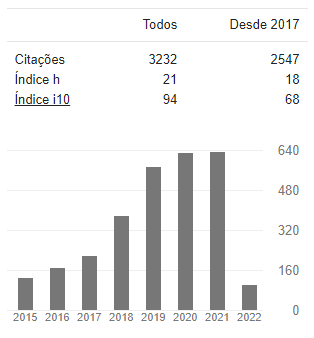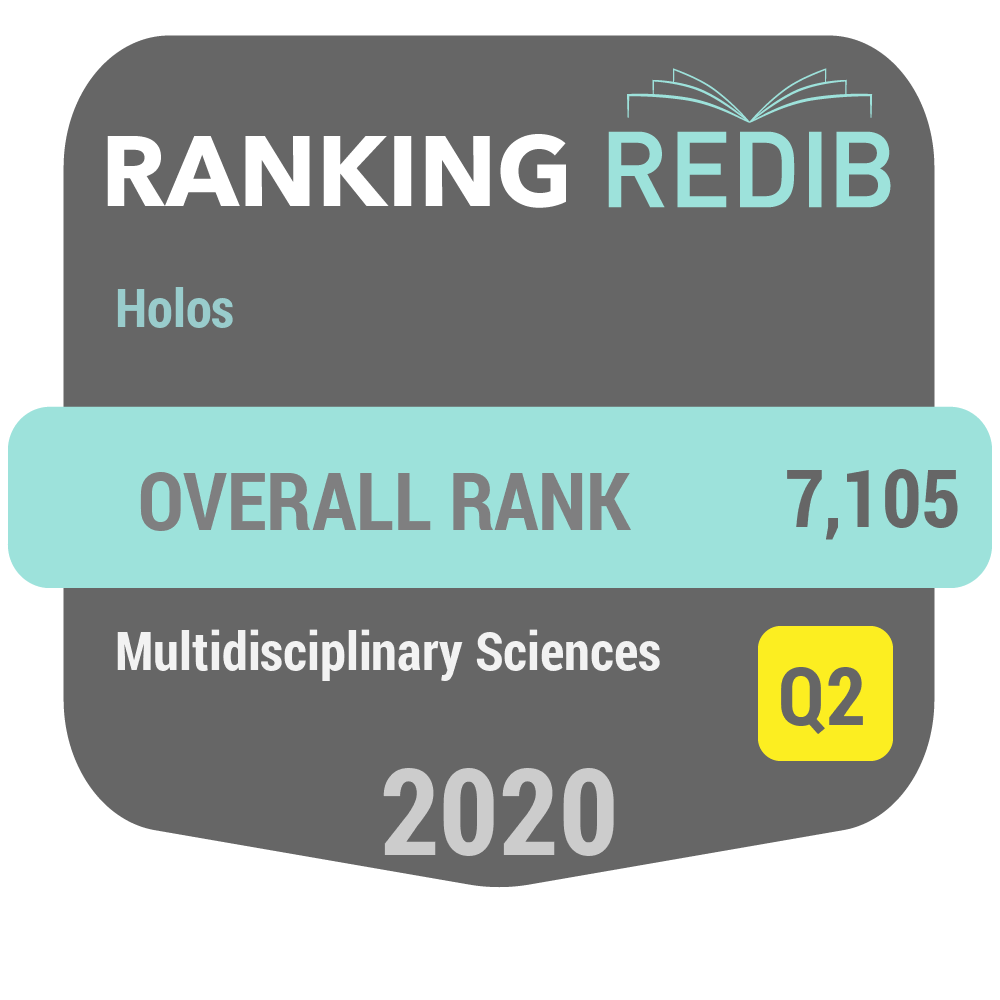INVESTIGAÇÃO NUMÉRICA DA IMPORTÂNCIA DE ARMADURAS DE FRETAGEM EM VIGAS PÓS-TRACIONADAS NÃO ADERENTES
DOI:
https://doi.org/10.15628/holos.2020.9566Palavras-chave:
Concreto protendido, pós-tração, comprimento de regularização, simulação numérica.Resumo
No concreto protendido, em razão da aplicação da força de protensão, a região das ancoragens é submetida à elevadas tensões. Ao longo de um trecho, denominado comprimento de regularização, a distribuição dessas tensões não é uniforme, estando a tensão de compressão, atuante na direção longitudinal do elemento estrutural, acompanhada de tensões nas direções transversais. Para resistir aos esforços transversais de tração, faz-se necessário a adoção de armaduras complementares, denominadas armaduras de fretagem, comumente utilizadas na forma de espirais, estribos secundários ou a combinação de ambos. Neste contexto, este trabalho teve como objetivo investigar o comportamento e a distribuição de tensões ao longo do comprimento de regularização de elementos protendidos, avaliando numericamente no software Abaqus® a influência e importância de armaduras de fretagem em tais elementos. Para tanto, foram simulados dois modelos numéricos, VE e VEF, com mesma quantidade de armadura longitudinal e transversal, diferenciando somente pelo fato de o modelo VEF possuir 3 estribos adicionais de fretagem em cada uma das extremidades da viga. No modelo VE o valor da tensão na armadura atingiu a tensão de escoamento do aço, situação indesejável em condições de serviço, enquanto no modelo VEF a tensão foi aproximadamente 20% menor, evidenciando, portanto, a importância de armaduras de fretagem em atendimento à segurança de vigas pós-tracionadas sem aderência.Downloads
Referências
AMERICAN CONCRETE INSTITUTE. 318-19: Building Code Requirements for Structural Concrete and Commentary. 2019.
ASSOCIAÇÃO BRASILEIRA DE NORMAS TÉCNICAS. NBR 6118: Projeto de estruturas de concreto - Procedimento. Rio de Janeiro, 2014.
AXSON, D. P. Ultimate Bearing Strenght os Post-tensioned Local Zones in Lightweight Concrete. Thesis (Master of Science In Civil Engineering) - Virginia Polytechinic Institute and State University, Blacksburg VA, 2008.
BASE, G. D.; REED, J. B.; BEEBY, A. W.; TAYLOR, H. P. J. An Investigation of the Crack Control Characteristics of Various Types of Bar in Reinforced Concrete Beams. Research Report Nº 18, Cement and Concrete Association, London, 1966.
BISCHOFF, P. H.; NAITO, C. J.; INGAGLIO, J. P. Immediate deflection of partially prestressed concrete flexural members. ACI Structural Journal, v. 115, n. 6, p. 1683-9A, 2018.
BONETTI, R.; ROBERTS-WOLLMANN, C. L.; SANTOS, J. T. Bearing Stenght of Confined Concrete. ACI Structural Journal, v. 111, p. 13-17, 2014.
BONOPERA, M., CHANG, K. C., CHEN, C. C., SUNG, Y. C., TULLINI, N. Experimental study on the fundamental frequency of prestressed concrete bridge beams with parabolic unbonded tendons. Journal of Sound and Vibration, v. 455, p. 150-160, 2019.
BURDET, O. L. Analysis and Design of Anchorage Zones in Post-tensioned Concrete Bridges. Dissertation (Doctor of Philosophy) – The University of Texas at Austin, Texas, 1990.
CERVENKA, V.; GANZ, H. R. Validation of Post-tensioning Anchorage Zones By Laboratory Testing and Numerical Simulation. Structural Concrete 15, n. 2, 2014.
CHEN, W.; HAO, H.; CHEN, S. Numerical analysis of prestressed reinforced concrete beam subjected to blast loading. Materials & Design, v. 65, p. 662-674, 2015.
DE OLIVEIRA, D. R. C.; JÚNIOR, O. A. S. Influência do Traçado do Cabo na Resistência ao Cisalhamento de Vigas de Concreto Protendido. Revista IBRACON de Estruturas e Materiais, v. 9, n. 5, 2016.
DU, J. S., AU, F., CHAN, E. K. H., LIU, L. Deflection of unbonded partially prestressed concrete continuous beams. Engineering Structures, v. 118, p. 89-96, 2016.
FUSCO, P. B. Técnica de Armar Estruturas de Concreto. 2ª Edição, Pini, São Paulo, 2013.
GERGELY, P.; SOZEN, M. A. Design of the Anchorage Zone Reinforcement in Prestressed Concrete Beams. PCI Journal, Vol. 12, p. 63-75, 1967.
GUO, Z. Principles of reinforced concrete. Butterworth-Heinemann, 2014.
GUYON, Y. Prestressed Concrete. John Willy and Sons, New York, 1953.
HAROON, S.; YAZDANI, N.; TAWFIQ, K. Posttensioned Anchorage Zone Enhancement With Fiber-Reinforced Concrete. Journal of Bridge Engineering, p. 566-572, 2006.
HENGPRATHANEE, S. Linear and Nonlinear Finite Element Analyses of Anchorage Zones in Post-tensioned Concrete Structures. Dissertation (Doctor of Philosophy In Civil Engineering) – Virginia Polytechinic Institute and State University, Blacksburg VA, 2004.
HOU, D., ZHAO, J., SHEN, J. S., CHEN, J. Investigation and improvement of strut-and-tie model for design of end anchorage zone in post-tensioned concrete structure. Construction and Building Materials, v. 136, p. 482-494, 2017.
KIM, J. R.; KWAK, H.; KIM, B.; KWON. Y.; BOUHJITI, E. M. Finite Element Analyses and Design of Post-tensioned Anchorage Zone in Ultra-high-performance Concrete Beams. Advances in Structural Engineering, p. 1-14, 2018.
KOMENDANT, A. E. Prestressed Concrete Structure. McGraw-Hill, New York, 1952.
KWON, Y.; KIM, J.; YANG, J. Development of efficient anchorage device and estimation of its bearing strength of posttensioning anchorage zone. Journal of Structural Engineering, v. 144, n. 3, p. 04017219, 2017.
MAO, W., GOU, H., YANNIAN H., PU, Q. Local Stress Behavior of Post-Tensioned Prestressed Anchorage Zones in Continuous Rigid Frame Arch Railway Bridge. Applied Sciences, v. 8, n. 10, p. 1833, 2018.
MARTÍ, J. V.; GARCÍA-SEGURA, T.; YEPES, V. Structural design of precast-prestressed concrete U-beam road bridges based on embodied energy. Journal of Cleaner Production, v. 120, p. 231-240, 2016.
MOREIRA, L. S.; SOUSA JR, J. B. M.; PARENTE JR, E. Nonlinear finite element simulation of unbonded prestressed concrete beams. Engineering Structures, v. 170, p. 167-177, 2018.
MÖRSH, E. Über die Berechnung der Gelenkquader. Béton und Eisen, Nº 12, 1924.
MOURA, M. W.; REAL, M. V.; LORIGGIO, D. D. Momento último de vigas de concreto protendido: validação e cálculo do erro do modelo. Revista IBRACON de Estruturas e Materiais, v. 11, n. 2, p. 307-330, 2018.
SHIN, H., YANG, J., YOON, Y., MITCHELL, D. Mix design of concrete for prestressed concrete sleepers using blast furnace slag and steel fibers. Cement and Concrete Composites, v. 74, p. 39-53, 2016.
YETTRAM, A. L.; ROBBINS, K. Anchorage Zone Stresses in Auxially Post-Tensioned Members of Uniform Rectangular Section. Magazine of Concrete Research, 21, p. 103-112, 1969.
YUN, Y. M. Evaluation of Ultimate Strength of Post-Tensioned Anchorage Zone. Journal of Advanced Concrete Technology, v. 3, n. 1, p. 149-159, 2005.
ZIELINSKI, J. L.; ROWE, R. E. An Investigation of the Stress Distribution in the Anchorage Zones of Post-Tensioned Concrete Members. Research Report Nº 9, Cement and Concrete Association, London, 1960.









































